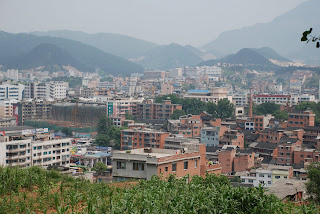

Uno de los principales highlights del viaje a Guizhou fue pasar el Día de las Carreras de Barcos Dragón (Dragon Boat Race Day) en Zhenyuan. Después de unos deliciosos tallarines picantes de desayuno, y una hora o así en el tren, llegamos a este pintoresco pueblo, cuyo centro histórico mantiene la arquitectura típica de la dinastía Ming (la penúltima dinastía china, que más o menos duró del siglo XIV al XVI). El entorno natural en aquel pueblo era realmente hermoso, nada más miren este puente:

La tradición del barco dragón es sumamente antigua, debe tener por lo menos unos 2,500 años de antiguedad que estas largas embarcaciones compiten en las aguas de los ríos chinos. Lo que no es tan reciente es que sea considerado un día de asueto nacional por el gobierno de la República Popular China, de hecho 2008 fue apenas el segundo año en el que esta fecha y el festival de otoño son incluidos en la lista oficial de días de descanso.

Parte fundamental de la motivación es el ritmo de este tambor, sentir aquellas percusiones realmente provocaba ganas de remar con toda la fuerza y ganar la competencia. Aquel domingo, en toda China estaban llevándose a cabo carreras como esta.

Junto con el barco, otra parte importante del ritual son los Zongzi... tamales de arroz hecho como masa. Cuenta la leyenda que, hace miles de años, el poeta Qu Yuan era tan patriótico que se suicidó cuando los invasores penetraron su reino. Entonces, la gente lanzo las bolitas de arroz en aras de evitar que los peces se comieran el cuerpo del poeta. Hay otra teoría cuyo argumento es que se tiraban los Zongzi al río para saciar el hambre del dragón y/o monstruos que ahi vivían; a la par que el ruido de los remos supuestamente los espantaba. Aquí vemos a una niña con su Zongzi:

Zhenyuan, que significa algo asi como el pueblo lejano, es un lugar de ensueño, tenía como principal atractivo turístico el Palacio Guanyin.

No me quedó muy claro si era un templo o la residencia de algún personaje influyente, pero eso no importa ya que pude disfrutar de un paseo sumamente agradable entre sus edificios, cuevas y jardines. Uno de los puntos que más llamó mi atención fue un mural que estaba pintado todo de blanco y tenía una placa explicando que estaba así para recordar los tiempos de la Revolución Cultural; cuando se busco una ruptura con la tradición y entre otras cosas populó el vandalismo. Dejando eso atrás, admiren la vista desde el edificio principal, seguro que alguien con mucho poder moró entre esas paredes.

Bien valió la pena no hacer rafting para quedarnos y explorar este encantador lugar.

Por cierto, cuando estaba tomando estas fotos no saben como me hubiera encantado tener una pistola de chinampines y dispararle a los globos con propaganda oficial... ¡rompen la armonia de la foto!. Ahora les muestro una foto de la comida de aquel día, practicamente todo tenía chile, pero, mmm, que rico.

Hablando de delicias locales… ¿Se les antoja comer un poco de perro?

Para cerrar con broche de oro, una foto cargando a Louisa, la foto brincona, y otra más de su servilleta.































